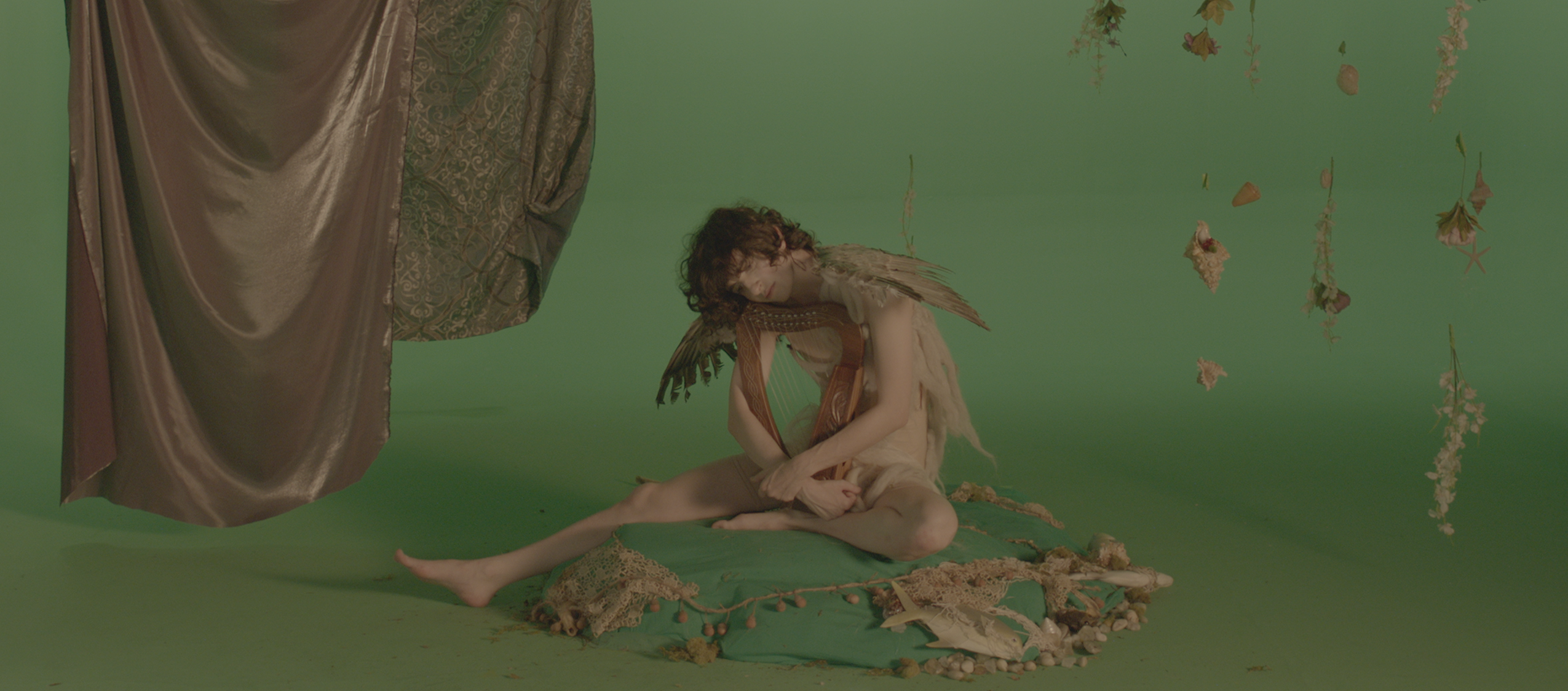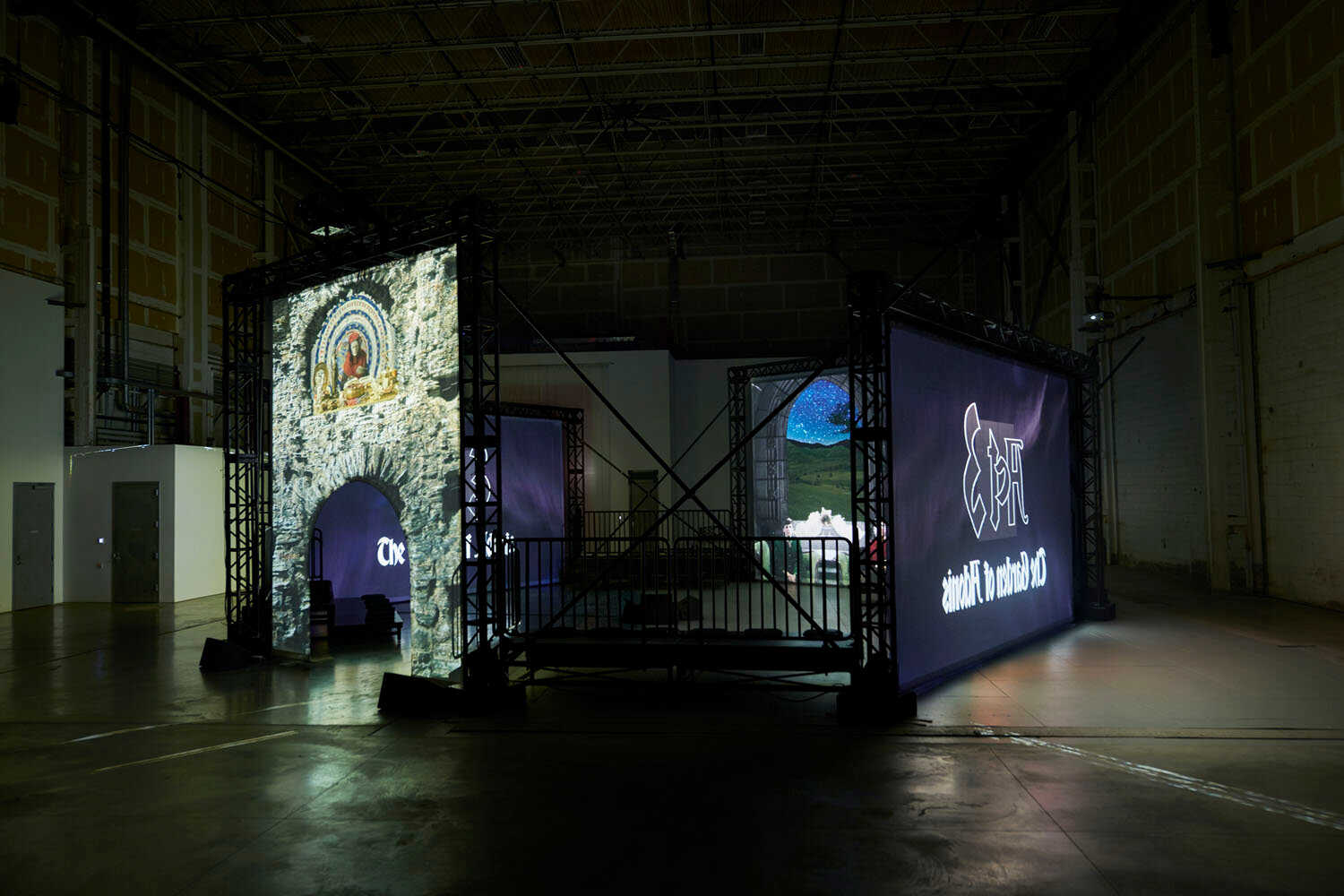
Credits:
By Diana Ryu and Mack Somers, Winter/Spring 2020 Curatorial Interns
March 23, 2020
Since 2010, Felix Bernstein and Gabe Rubin have been working collaboratively on live performances, film projects, and multimedia exhibitions. Their multifaceted production is primarily informed by drag performance, queer theory, greek mythology/tragedy, and social media. The video installation Vomitorium, one of their largest-scale projects to date and their first project with The Kitchen, extends Bernstein and Rubin’s ongoing analysis of madness and mimesis in drag and trans performance.
Installed at Queenslab, The Kitchen’s partner venue in Ridgewood, Vomitorium is an octagonal amphitheater comprising four screens and four sets of risers, all facing the open center. From their seats, viewers can watch the three-hour video unfold while simultaneously watching other viewers situated around the amphitheater, creating a panoptic experience. Rubin plays figures from Greek mythology, leading the video’s amorphous narrative, while Bernstein plays Onkos—named after the tumorous masks of Greek tragedy—who falls into a degenerative feedback loop of grief.
As the film progresses, Rubin alternates between stage sets and costumes across three screens while Bernstein’s voice emanates from behind the mask of Onkos on one screen, narrating the history of metatheatre. “Metatheatre” is a term, coined by the playwright Lionel Abel, used to denote self-reflexive characteristics found in theater, such as when the characters are aware of their own theatricality, the audience’s presence is acknowledged, or the devices of production are laid bare. The term has been loosely interpreted throughout modern theater, with prominent examples appearing in the works of playwrights Bertolt Brecht and Jean Genet—both of whom have been inspirations for Bernstein and Rubin.
Vomitorium opened on February 22 and was scheduled to remain on view through March 22 (it closed early in response to COVID-19). While the installation was open, Spring 2020 Curatorial Interns Diana Ryu and Mack Somers had the chance to speak with Bernstein and Rubin further about their interests in metatheatre and their ever-evolving collaborative process.
In your interview with Nick Bennett for The Brooklyn Rail, you noted that your creative partnership began as first-year students at Bard College, bonding over “the middlebrow aesthetic” of musical theater. Could you talk about how your collaborative dynamics have evolved as you continue working together?
Gabe Rubin [GR]: For the past few years, I have done most of the video editing and production design, while Felix does most of the writing. We still continuously review each other’s work, but our process is always also compartmentalized between the two of us. We’re doing very independent parts of the project but often side by side.
This project, in particular, is a lot about preserving emotional closeness while being physically distant. And what was exciting about it, for me, was not having to share the frame. Our last project, Folie à Deux (2018), was so much about our shared gaze, how we were positioned in the frame together, and who was going to take up more space. Vomitorium became very much about our isolated, embodied experiences of looking at each other from afar.
Felix Bernstein [FB]: And that includes us looking into and at split-off aspects of ourselves from a distance.

How were you engaging with metatheatre, which describes qualities of theater that blur the separation between the stage and the audience, in the production and post-production of Vomitorium?
FB: At least a century before the theory of metatheatre, Thomas de Quincy discussed how the modern theater of Shakespeare attained reflexivity through self-reflection, and made subjective interiority into a Mise en abyme (hall of mirrors), while ancient Greek theater manifested reflexivity through external exaggeration, physiological mirroring, and architectural framing. We tried to combine both in this project.
GR: I think we worked to bridge those styles through mixing the visual nesting-doll framings of post-production with the hyper-self-critical monologues of the production. Almost everything was shot on a green screen, so all of the landscapes are either stock video or footage that I shot in nature and then composited onto the green screen. Some elements are computer generated like the clouds, while others function like Snapchat filters, such as the mask Felix wears as Onkos.
FB: The confusion over real and fake, with clouds and with faces, is also made part of the dialogue. Especially in the sections that adapt Gian Lorenzo Bernini’s Baroque play The Impresario, which is set in an artist’s studio as he attempts to craft ways to fool his audiences and protect his secrets.
Could you speak more about the connections you draw between social media and metatheatre? Both are public stages of enactment, but the audience and the way people receive and view the works vary across these contexts. Particularly with Vomitorium, which is three hours long, it is impossible to ensure that the audience watches the piece from the very beginning to the very end. How were you negotiating the engagement of the viewer for this piece?
GR: I was pretty surprised that people actually sat in the space and watched Vomitorium during the opening as though it were a traditional film in a movie theater. People often didn’t sit and watch our last project, Madame de Void (2018), which was a narrative film. Maybe this is because, with Vomitorium, once you’re bored with one of the screens, you can look at the other one.
FB: We’re also dealing with ideas that are fundamentally not entertaining, despite being about the construction and consumption of entertainment. We created this uncomfortable situation in which there is enough of a narrative that people expect to be entertained but just enough that they can be disappointed. So I hope it’s a little bit tense in that audiences look for something to be either ambient or narrative, which is a division we wanted to work against.
Vomitorium primarily revolves around the character played by Bernstein called Onkos, who encapsulates the overall cynical and sarcastic tone of the tragicomedy, and the cherub-like Erotes played by Rubin, who guides Onkos with a more exuberant flair. Given these varied tones present within the piece, is there any particular impression you wanted the audience to leave with?
GR: I’m kind of a melodramatic softie. I always want to end with a moment of sincerity or clarity. Especially after such a long, academic, meandering speech, I need to have a moment where it feels earnest. For me, this happens in the “No Need to Argue” song, but still, I don’t know if the ending is any less cynical or digressive.
FB: I think it is challenging to give narrative closure to something that is destined to re-loop and question itself. Aristotle’s writings on theater could qualify as metatheatre but they are, of course, willfully less dialogic than Plato. We wondered if we could create a dramatic arc, in which there is movement, feeling, and rhythm, for a debate on theater. We were working with material that made this process very difficult.
This project did feel more like theater in that we worried, even as it was up and running, that it would get out of sync, and that it would fail to adhere into an objective correlative. There was something alive in that stage fright.
GR: I think we rely on the vomit in the final scene quite a bit for the dramatic arc Felix mentions. It feels like our process was a rapid intake of information and then an expulsion, but it was never actually digested. So that’s why it is like vomit.
FB: And if we’re talking about the future, this wasn’t the final purge. There is another seven hours of footage that we don’t show in this film that we will show at Luma Westbau in Zürich this summer. Again, there is the question of whether the catharsis worked or ever works. For me, I do feel we got a lot off our chest, so to speak. It sounds paradoxical, but in some sense, I do think we’ve finished the film. We have one more part of it, and then it’s done.
You have experimented in your work with various mediums including poetry, critical writing, film, performance, and sculpture. Are there ideas or projects in your future that you are excited about?
GR: I hope to only grow more operatic and Baroque.
FB: This project was about resisting the panoptical experience of multimedia spectacle but also resisting that resistance. I don’t think picking a side is a solution. We have to work through the interplay of immersion and distance, and we can’t control or even predict how they will combine or divide in the future.
